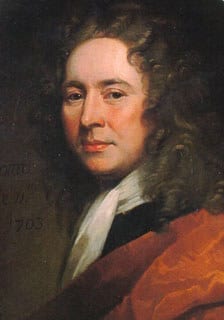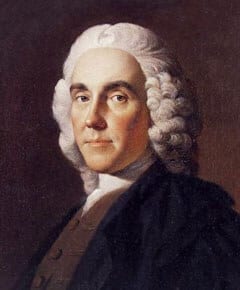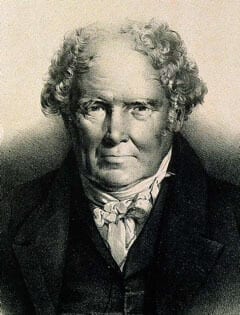JMS Pearce
Hull, England, United Kingdom
 |
|
Figure 1. John Monro |
In medieval times Celtic life was based on a clan system of lineage in certain territories. Each clan had a chief, kinsmen, and families who worked and lived on their lands. The treatment of illness within the entire clan was the responsibility of a medically trained physician, a selected member of that clan who worked by legal requirement. The role of physician was handed down to successive generations by tradition. Much of the physician’s time was devoted to the more socially elevated and privileged members of the community, as commoners often depended on healers, herbalists, and folklore remedies. In Celtic Scotland, several such medical families attended royalty as well as their own clans. This system petered out gradually in the seventeenth and eighteenth centuries, though until the 1780s in the Western Isles the hereditary medical dynasties still worked as physicians to the great families.
The celebrated Monro Dynasty began with the Scottish army surgeon John Monro (1670-1740) (Fig 1), and extended continuously in Edinburgh from 1720 to 1846.1 John established the family seat at Auchinbowie House, near Stirling. Monro was the son of Sir Alexander Monro (1629–1704), commissary of Stirling. John studied medicine at Leiden and would become a major influence in the formation of the Edinburgh School of Medicine. He was admitted to the Incorporation of Surgeons of Edinburgh in 1703 and elected Deacon.
The eighteenth century saw the growth of scientific medicine in Edinburgh. The University of Edinburgh Medical School, together with the Royal Infirmary (established in 1729), were responsible for the systematic teaching of medicine. Surgery, however, was thought of as a manual craft and was left to the Incorporation of Surgeons to establish its importance. Eventually, in 1778, King George III granted a new charter giving the surgeons’ corporation the title “The Royal College of Surgeons of the City of Edinburgh.”
Alexander Monro primus (1697-1767)
 |
|
| Figure 2. Monro Primus |
Monro primus (Fig 2), surgeon and anatomist, was born in London and the only surviving son of John Monro and his wife, Jean Forbes. The youthful Alexander attended the University of Edinburgh from 1710 to 1713. He was educated in Greek, Latin, French, natural philosophy, and mathematics before becoming an apprentice to his father about 1713. In 1717, Alexander studied anatomy under the renowned William Cheselden in London. He proceeded to Paris in 1718 and then to Leiden, studying medicine under the great Herman Boerhaave with texts written in Latin. On Boerhaave’s recommendation he visited the anatomist Frederik Ruysch in Amsterdam to learn the art of making anatomical preparations.2
Although the official establishment of the Faculty of Medicine was still six years away, he was appointed University Chair of Anatomy in 1720. His aim was to install the finest practices of Boerhaave’s esteemed Dutch training. Although he himself was a surgeon, he tried to exclude his surgical colleagues from both the university and the infirmary. Many historians have viewed Monro’s appointment as the beginning of the Edinburgh Medical School,3,4 owing much to the tradition of nepotism through his father and the patronage of Provost George Drummond, a leading Edinburgh councillor.2 In 1756 he obtained his MD and a license to practice from the Royal College of Physicians of Edinburgh, becoming a Fellow the next year.
In 1729 he rented a house off Cowgate, with six beds for the sick poor, in order to provide clinical training for students. This house formed the roots of the Edinburgh Infirmary; a larger building designed by William Adam, which opened to patients in 1741.
He gave lecture courses in anatomy from 1720 until 1758 using wax models for instruction. He only used one or two cadavers, revealing the shortage of bodiesi for dissection long before the infamous body-snatchers Burke and Hare operated in Edinburgh (1827–1828). Highly regarded as a teacher, Monro related competing theories and offered critical opinions on their fallacies. He readily confessed his own ignorance on controversial points and lectured in English rather than Latin. In 1726 Monro published his only textbook, without illustrations: The Anatomy of the Human Bones. It proved to be so popular that its 7th edition was published in 1763.
Monro primus was an active citizen of Enlightenment Edinburgh: a man with great personal magnetism and a philanthropist. He developed rectal cancer and died in 1767. His medical sons were Alexander secundus (1733–1817) and Donald (1728–1802), a physician at St George’s Hospital, London.
Alexander Monro secundus (1733–1817) FRSE FRCPE
 |
| Figure 2. Monro Secundus |
The second and most accomplished Monro4 was the third son of Monro primus and Isabella MacDonald of Skye. He was born in Edinburgh and with his brother Donald attended James Mundell’s school. Monro primus had assiduously educated his sons to fill with distinction his position as Professor of Medicine. Monro secundus (Fig 3) began attending his father’s anatomy classes at the tender age of eleven, and his formal medical studies in 1750. In 1753 while still a student, he took over the teaching of his father’s summer anatomy class and was precociously named joint Professor of Medicine and Anatomy on 10 June 1754. He graduated MD in 1755 and further studied anatomy, first in London under William Hunter (brother of John Hunter), and then with Johann Meckel (of the diverticulum) in Leiden. His father became ill causing him to return home and take up full duties of the professorship in 1758. He became a Fellow of the Royal College of Physicians of Edinburgh (established by Royal Charter of Charles II in 1681) in 1759 and served as President from 1779 to 1782.
For fifty years he taught at Edinburgh University and was the most influential anatomy professor in the English speaking world, 16 lecturing daily with diligent preparation of his anatomical specimens. His lectures were praised for their clarity and strength of argument. However, in 1777 he had the title of his professorship formally changed to the Chair of Medicine, Anatomy, and Surgery, preventing the independent establishment of a course in surgery in Edinburgh.4 Like his son he was a physician without surgical training; the change was, unsurprisingly, resented by the Incorporation of Surgeons.
In the spirit of the Enlightenment, Monro conducted animal experiments, mainly on the nervous system.5 In 1764 he read Communication of the Ventricles of the Brain to the Edinburgh Philosophical Society (published 1783). It recorded that during a dissection of a hydrocephalic brain he discovered the foramen between the lateral ventricles and the third ventricle, which was named the foramen of Monro.
 |
| “Communication of the Ventricles of the Brain” |
But several anatomists disputed his claims for originality and accuracy and a heated argument arose.6 Most notably, Sir Charles Bell (1774-1842), the celebrated Edinburgh-trained anatomist, attacked him7 for presuming to describe something that was already well known to Vesalius (1514–1564), Thomas Willis (1621–1675), Swedenborg, Winslow, and Haller. Years later, Monro felt obliged to verify his claim:
An oval hole, situated under the anterior part of the body of the fornix; behind the anterior crura of the fornix and commissura anterior cerebri; on the forepart of the joining of the choroid plexuses of the two lateral ventricles of the brain; and over the fore part of the third ventricle. Hence, at this place, the lateral ventricles of the brain communicate with each other and with the third ventricle.8
He declared he had demonstrated this to his students “so far back as the year 1753, soon after I began the study of Anatomy.”
Monro secundus was no stranger to dispute.9 His thesis had described the lymphatic system as absorbent and separate from the circulatory system. But his former teacher William Hunter (1718-1783) objected, stating that he had been teaching the same theory for many years, and accused Monro of stealing his idea. Monro also argued with Gilbert Blane (1749-1834) about the function of oblique muscles. At the time there was probably a good deal of rivalry between the Edinburgh and London schools. Bell’s early success in Edinburgh had caused local jealousy, and he was effectively barred from practice at the Royal Infirmary. Bell therefore moved to London in 1804, where he set up his private anatomy school at the Great Windmill School of Anatomy, founded by William Hunter.
Monro’s writings included: Microscopical Inquiries into Nerves and Brain, (1780); The structure and physiology of fishes explained; and compared with those of man and other animals (1785); A Description of all the Bursae murcosae of the Human Body (1788); Experiments on the nervous system, with opium and metalline substances, made chiefly with the view of determining the nature and effects of animal electricity (1793); and Three Treatises. On the Brain, the Eye, and the Ear (1797).
In Observations on the Structure and Functions of the Nervous System (1783), he established the Monro-Kellie doctrine, which stated: the cerebral volume of blood must remain constant unless “water or other matter is effused or secreted from the blood-vessels” in which case “a quantity of blood, equal in bulk to the effused matter will be pressed out of the cranium.” Thus a change in the volume of blood, brain, or cerebrospinal fluid would result in reciprocal changes in one or both of the other two.10 This was confirmed by his former student Kellie forty years later.11
He was considered a friendly and gregarious but argumentative man, often critical of other anatomists. In 1813 he had an attack of apoplexy and died in 1817.
Alexander Monro tertius (1773–1859)
 |
|
| Figure 4. Monro Tertius |
Monro secundus had married Katherine Inglis, with whom he had two daughters and three sons. The eldest, Alexander Monro tertius (Fig 4), graduated Doctor of Medicine in Edinburgh in 1797. Shortly after he was elected Licentiate, then Fellow of the Royal College of Physicians of Edinburgh, and became President from 1825 to 1827.
He studied anatomy in London and Paris, returning to Edinburgh in 1800 when he was appointed conjoint (with his father) Professor of Medicine, Surgery, and Anatomy. From 1808 he delivered the whole course, and on his father’s death in 1817 he was appointed full Professor. He held this position until 1846 and carried out his teaching duties but “was unpopular . . . and did not measure up to the standards set by his father and grandfather.”12 Charles Darwin, who attended these lectures, in The Life and Letters of Charles Darwin, commented: “He made his lectures on human anatomy as dull as he was himself.” Like his forebears, Monro opposed the development of a separate course in surgery.
Although his publications “were largely unpopular and displayed unclear reasoning”12 they include: Morbid Anatomy of the Human Gullet, Stomach, and Intestines (1811), Outlines of the Anatomy of the Human Body (1813), Morbid Anatomy of the Brain, volume 1, Hydrocephalus (1827), The Anatomy of the Brain (1831), Essays and Heads of Lectures of A. Munro secundus, with Memoir (1840), and Anatomy of the Urinary Bladder and Perinaeum in the Male (1842).
He suffered by comparison with his distinguished father and grandfather.13 He retired in 1846 and died in 1859. There is apparently no truth in the story that Monro tertius lectured from the notes of Monro primus.3
The Bedlam Monros
Interestingly there was another branch of the same family, hailing from Hugh Munro, 9th Baron of Foulis (c.1352-1425). George Munro succeeded his father Hugh, and many generations later produced James Monroii (1680-1752). He was the first of five generations of physicians, four of whom practiced at the Bethlem Hospital between 1728 and 1882.5 Known as the Bedlam Monros, they were a powerful if much criticized influence in the management of the insane in London.
Conclusion
The Faculty of Medicine in the University of Edinburgh was established in 1726 and John Monro, father of the Monro dynasty, and Deacon of the Incorporation of Surgeons from 1712 to 1713 made a major contribution in this achievement. The enumeration of the three Monros will not change, but the accomplishments of surgeon John Monro (1670-1740) might justify his being called Monro primus, and his three successors renumbered.
The town council formally appointed professors at Edinburgh. This was an accepted if nepotistic practice, since professorships were treated as the property of their holders, who often arranged their transfer to sons with only perfunctory outside review.14 The Monros more conspicuously than other families followed this dynastic practice but they did much to advance the field of medicine.
Other famous Celtic Scottish medical dynasties10 included: the MacBeth or MacBeatha family (in English “Beaton” and in French “Bethune”), who originated in Ireland and came to Scotland around 1300 AD. It was often said that a Beaton physician attended every Scottish King from the fourteenth through the eighteenth centuries. One of them probably attended King James VI ( I of England) on his deathbed. David Maclagan (1785-1865), a president of both the Royal College of Surgeons and Royal College Physicians of Edinburgh, had four distinguished medical sons and a grandson. Benjamin Bell (1749–1806) and his three successive generations of Edinburgh surgeons were each the deacon or president of the Royal College of Surgeons of Edinburgh. James Gregory (1674–1733), Professor of Medicine at King’s College Aberdeen, had two sons, James and John; one grandson, James, succeeded him in that chair while another grandson, William, held the chair of medicine in Aberdeen. The attachment to clans of hereditary learned men began to decline in the seventeenth century and largely disappeared by 1800.
The Barber Surgeons of Edinburgh were formally incorporated as a Craft Guild of the city and this recognition is embodied in the Seal of Cause or Charter of Privileges granted to the Barber Surgeons by the Town Council of Edinburgh in 1505. With the passing of successive Monros’ opposition, in 1778 King George III granted a new charter whereby the Surgeons were incorporated anew under the title “Royal College of Surgeons of the City of Edinburgh.” A further charter, granted by Queen Victoria in 1851, separated the College from the Town Council.
Endnotes
- This led to the Anatomy Act 1832 which allowed doctors and anatomists greater access to cadavers
- Alexander Monro (c1648-1698) changed the spelling of his name from Munro to Monro for reasons which are not clear.
References
- Wright-St Clair, RE. Doctors Monro: a medical saga. London. The Wellcome Historical Medical Library, 1964.pp. 27-37.
- Guerrini Anita. Monro, Alexander, primus. Dictionary of National Biography. Oxford University Press 2018. https://doi.org/10.1093/ref:odnb/18964
- Ellis H. The deaths of the Alexander Monros, distinguished Scottish anatomists. Br J Hosp Med (Lond). 2017; 2;78(7):407.
- William Hunter and the Eighteenth-Century Medical World. Eds. W. F. Bynum, Roy Porter. Cambridge: Cambridge Univ Press1985:pp 157-167.
- Macintyre I, Munro A. The Monros – three medical dynasties with a common origin. J.R Coll Physicians Edinb 2015; 45: 67–75. http://dx.doi.org/10.4997/JRCPE.2015.116
- Pearce JMS. The Monro Bell controversy. Clin Anat. 2013;26(7):793-9.
- Bell C. 1802. The Anatomy of the Brain. London: Longman and Co.
- Monro A (secundus). Treatise on the Brain, the Eye, and the Ear. Edinburgh 1797, p. 22.
- Sharp JA. 1961. Alexander Monro Secundus and the interventricular foramen. Med Hist 5:83-89.
- Monro A. Creech & Johnson; Edinburgh: 1783. Observations on the Structure and Function of the Nervous System.
- Kellie G. An account of the appearances observed in the dissection of two of the three individuals presumed to have perished in the storm of the 3rd, and whose bodies were discovered in the vicinity of Leith on the morning of the 4th November 1821 with some reflections on the pathology of the brain. Trans Medico Chirurg Soc Edinburgh 1824; 1: 84–169.
- Royal College of Physicians of Edinburgh, Medical Biographies, 2018 https://www.rcpe.ac.uk/heritage/college-history/alexander-monro-tertius
- Rosner L. In: Monro, Alexander, tertius. Oxford Dictionary of National Biography, 23 Sept 2004. https://doi.org/10.1093/ref:odnb/18966
- Rosner L. In: Monro, Alexander, tertius. Oxford Dictionary of National Biography, 23 Sept 2004 .https://doi.org/10.1093/ref:odnb/18966
JMS PEARCE, MD, FRCP, is emeritus consultant neurologist in the Department of Neurology at the Hull Royal Infirmary, England.
Highlighted in Frontispiece Volume 10, Issue 4– Fall 2018
Summer 2018 | Sections | History Essays

Leave a Reply